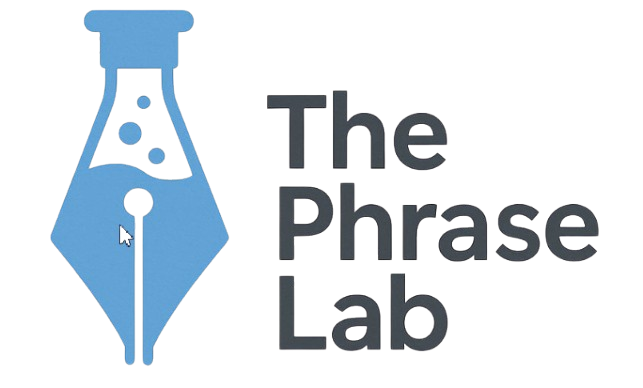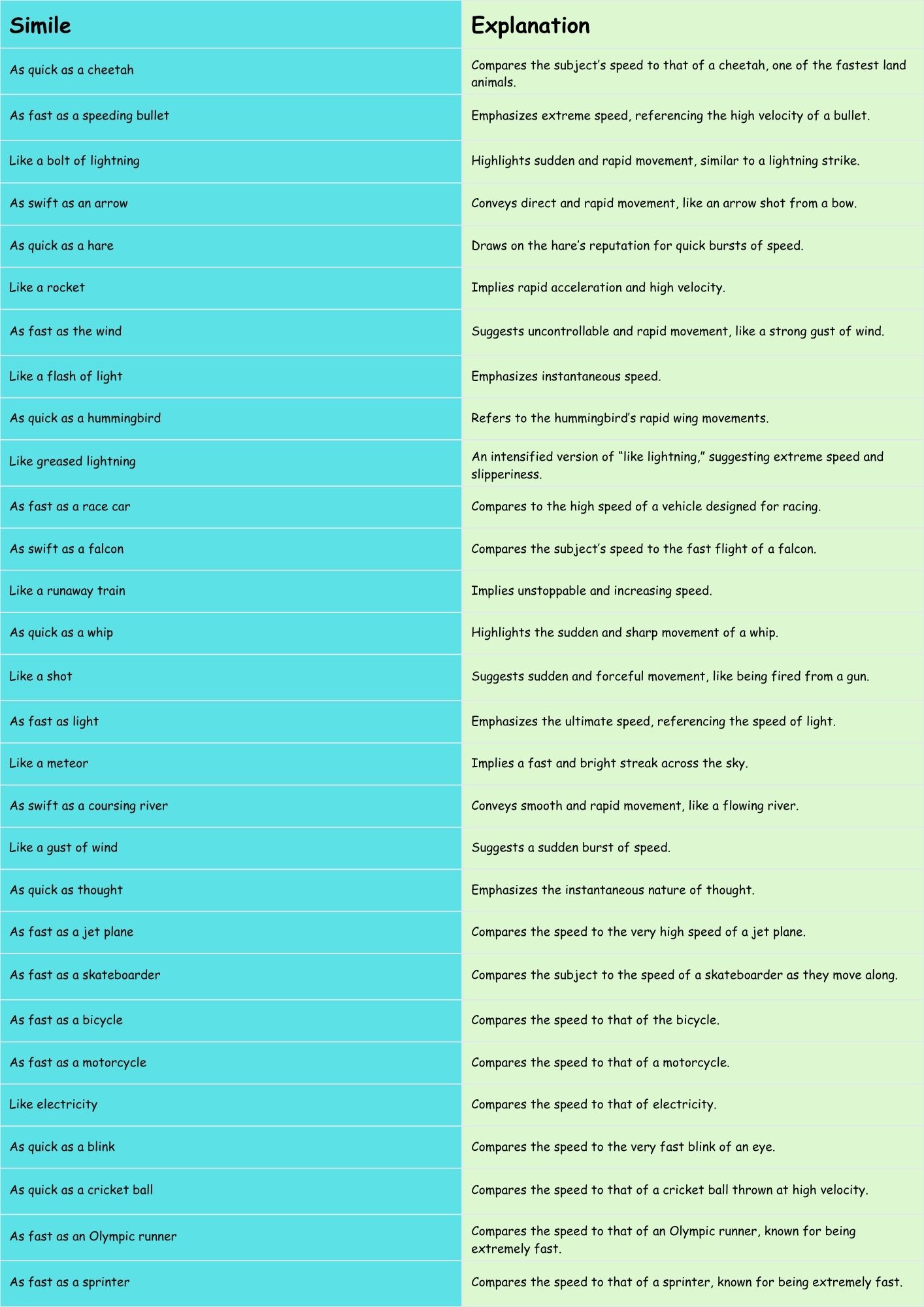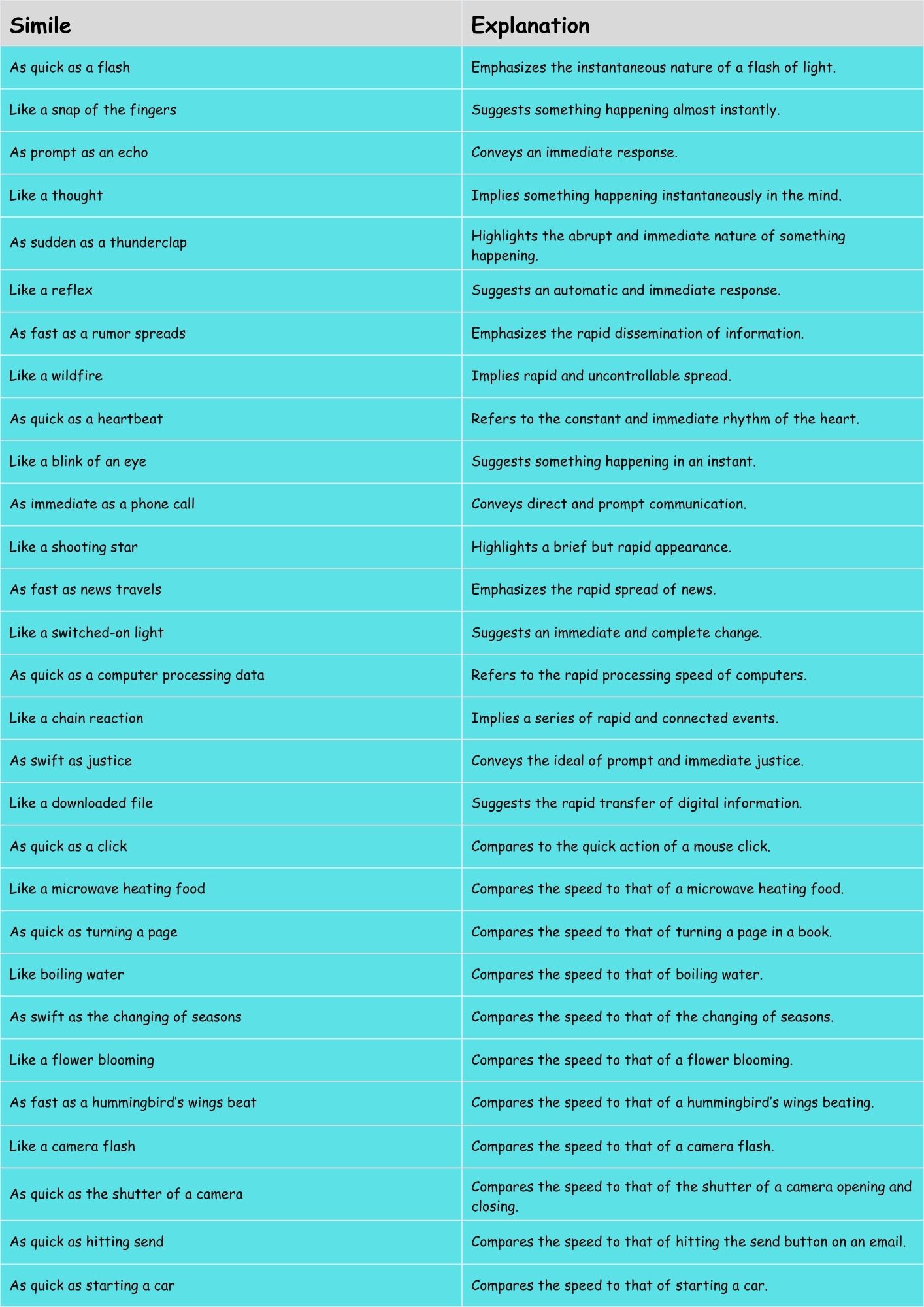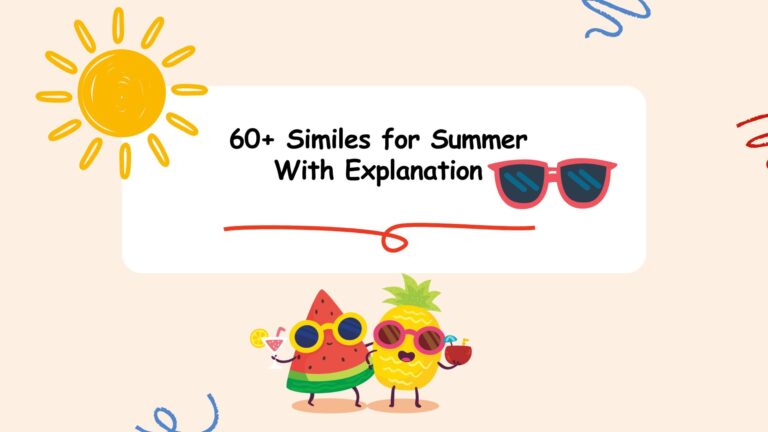
Similes for Quick: Mastering Figurative Language

Understanding similes is crucial for enhancing your writing and comprehension skills in English. Similes, which compare two unlike things using “like” or “as,” add vividness and depth to descriptions. This article provides a comprehensive guide to similes for “quick,” exploring their structure, usage, and impact. Whether you’re a student, writer, or language enthusiast, this resource will equip you with the knowledge and practice to effectively use similes to convey speed and agility.
This article will cover various types of similes used to describe quickness, offering numerous examples and practical exercises to reinforce your learning. By the end of this guide, you’ll be able to identify, interpret, and create compelling similes that capture the essence of speed and swiftness in your writing and speech.
Table of Contents
- Introduction
- Definition of Simile
- Structural Breakdown of Similes for “Quick”
- Types of Similes for “Quick”
- Examples of Similes for “Quick”
- Usage Rules for Similes
- Common Mistakes When Using Similes
- Practice Exercises
- Advanced Topics in Similes
- Frequently Asked Questions
- Conclusion
Definition of Simile
A simile is a figure of speech that compares two unlike things using the words “like” or “as.” The purpose of a simile is to create a vivid image or convey a specific quality by associating it with something familiar or easily understood. Similes are a fundamental tool in descriptive writing and are used to enhance clarity, add emphasis, and engage the reader’s imagination. They are a subset of figurative language, which also includes metaphors, personification, and hyperbole.
In the context of describing “quick,” similes are used to illustrate the speed, agility, or rapidity of an action or object. For instance, saying someone is “as quick as a flash” uses the sudden and instantaneous nature of a flash to emphasize the person’s speed. The effectiveness of a simile lies in the strength and relevance of the comparison. A well-chosen simile can transform a mundane description into something memorable and impactful.
Structural Breakdown of Similes for “Quick”
Similes generally follow a simple structure: A is like B or A is as [adjective] as B. In the context of describing something that is “quick,” this structure can be broken down further:
- Subject (A): The person, object, or action being described as quick.
- Linking Verb (is/was/seems): Connects the subject to the comparison.
- Comparison Words (like/as): Signals that a simile is being used.
- Adjective (optional): An adjective that describes the quality being compared (e.g., “fast,” “swift,” “rapid”). This is used with “as.”
- Object of Comparison (B): The thing to which the subject is being compared, which is known for its quickness.
For example, in the simile “He was as quick as a cheetah,” “He” is the subject, “was” is the linking verb, “as quick as” is the comparison phrase, and “a cheetah” is the object of comparison. The choice of the object of comparison is crucial. A cheetah is known for its speed, making it an effective comparison for someone who is quick.
Another example: “Her response was like lightning.” Here, “Her response” is the subject, “was” is the linking verb, “like” is the comparison word, and “lightning” is the object of comparison. The suddenness of lightning effectively conveys the immediacy and quickness of her response.
Types of Similes for “Quick”
Similes for “quick” can be categorized based on the specific aspect of quickness they emphasize. Here are three main categories:
Similes Emphasizing Speed and Velocity
These similes focus on the rate at which something moves or operates. They often involve comparisons to fast-moving animals, objects, or natural phenomena.
Similes Emphasizing Agility and Nimbleness
These similes highlight the ability to move quickly and easily, often with precision and grace. They might compare someone or something to acrobats, dancers, or agile animals.
Similes Emphasizing Rapidity and Promptness
These similes emphasize the speed with which something happens or is done, often focusing on immediacy and lack of delay. They can involve comparisons to things that happen instantly or without hesitation.
Examples of Similes for “Quick”
The following sections provide extensive examples of similes for “quick,” categorized by the aspect of quickness they emphasize.
Examples Emphasizing Speed
These similes illustrate raw speed and velocity. They are ideal for describing fast-moving objects, animals, or people.
The table below provides a variety of similes that emphasize speed, showcasing different objects and animals known for their velocity.
| Simile | Explanation |
|---|---|
| As quick as a cheetah | Compares the subject’s speed to that of a cheetah, one of the fastest land animals. |
| As fast as a speeding bullet | Emphasizes extreme speed, referencing the high velocity of a bullet. |
| Like a bolt of lightning | Highlights sudden and rapid movement, similar to a lightning strike. |
| As swift as an arrow | Conveys direct and rapid movement, like an arrow shot from a bow. |
| As quick as a hare | Draws on the hare’s reputation for quick bursts of speed. |
| Like a rocket | Implies rapid acceleration and high velocity. |
| As fast as the wind | Suggests uncontrollable and rapid movement, like a strong gust of wind. |
| Like a flash of light | Emphasizes instantaneous speed. |
| As quick as a hummingbird | Refers to the hummingbird’s rapid wing movements. |
| Like greased lightning | An intensified version of “like lightning,” suggesting extreme speed and slipperiness. |
| As fast as a race car | Compares to the high speed of a vehicle designed for racing. |
| As swift as a falcon | Compares the subject’s speed to the fast flight of a falcon. |
| Like a runaway train | Implies unstoppable and increasing speed. |
| As quick as a whip | Highlights the sudden and sharp movement of a whip. |
| Like a shot | Suggests sudden and forceful movement, like being fired from a gun. |
| As fast as light | Emphasizes the ultimate speed, referencing the speed of light. |
| Like a meteor | Implies a fast and bright streak across the sky. |
| As swift as a coursing river | Conveys smooth and rapid movement, like a flowing river. |
| Like a gust of wind | Suggests a sudden burst of speed. |
| As quick as thought | Emphasizes the instantaneous nature of thought. |
| As fast as a jet plane | Compares the speed to the very high speed of a jet plane. |
| As fast as a skateboarder | Compares the subject to the speed of a skateboarder as they move along. |
| As fast as a bicycle | Compares the speed to that of the bicycle. |
| As fast as a motorcycle | Compares the speed to that of a motorcycle. |
| Like electricity | Compares the speed to that of electricity. |
| As quick as a blink | Compares the speed to the very fast blink of an eye. |
| As quick as a cricket ball | Compares the speed to that of a cricket ball thrown at high velocity. |
| As fast as an Olympic runner | Compares the speed to that of an Olympic runner, known for being extremely fast. |
| As fast as a sprinter | Compares the speed to that of a sprinter, known for being extremely fast. |
Examples Emphasizing Agility
These similes focus on the ability to move quickly and gracefully, often with precision and control. They are suitable for describing dancers, athletes, or anyone who exhibits nimble movements.
The table below showcases similes that highlight agility, comparing subjects to entities known for their graceful and precise movements.
| Simile | Explanation |
|---|---|
| As agile as a cat | Compares the subject’s agility to that of a cat, known for its graceful movements. |
| Like a dancer | Suggests graceful and coordinated movements. |
| As nimble as a squirrel | Draws on the squirrel’s quick and agile movements in trees. |
| Like a gymnast | Implies flexibility and precise control over body movements. |
| As light as a feather | Conveys effortless and graceful movement. |
| Like a shadow | Suggests quick and elusive movements. |
| As graceful as a swan | Highlights elegance and fluidity in movement. |
| Like a ninja | Implies stealth and quick, precise movements. |
| As quick as a monkey | Refers to the monkey’s agility and climbing skills. |
| Like water flowing | Suggests smooth and adaptable movements. |
| As flexible as a reed | Conveys the ability to bend and move easily. |
| As sure-footed as a mountain goat | Highlights the ability to move quickly and safely in challenging terrain. |
| Like a butterfly | Suggests light, fluttering movements. |
| As coordinated as a ballet dancer | Emphasizes precise and synchronized movements. |
| Like a fish in water | Implies natural and effortless movement within a specific environment. |
| As light-footed as a deer | Conveys graceful and quiet movements. |
| Like a spider | Suggests quick and precise movements, especially in climbing or navigating complex spaces. |
| As deft as a surgeon | Highlights precision and skill in movement. |
| Like a seasoned acrobat | Compares the subject to the agility and balance of a seasoned acrobat. |
| As agile as a fox | Compares the subject to the cunning and agility of a fox. |
| Like a hummingbird | Compares the subject to the agility of the hummingbird, known for its ability to hover and move in any direction. |
| Like a martial artist | Compares the subject to the agility and precision of a martial artist. |
| As quick as a snake | Compares the subject to the speed and agility of a snake. |
| Like a gymnast on the beam | Compares the subject to the balance and agility of a gymnast on the balance beam. |
| As maneuverable as a jet fighter | Compares the subject to the maneuverability and agility of a jet fighter. |
| Like a fencer | Compares the subject to the agility and precision of a fencer. |
| As quick as a pickpocket | Compares the subject to the speed and agility of a pickpocket. |
| As light as air | Compares the subject to the lightness and ease of air. |
| Like a professional gamer | Compares the subject to the speed and agility of a professional gamer. |
Examples Emphasizing Rapidity
These similes emphasize the speed with which something happens or is done. They are useful for describing quick reactions, responses, or processes.
The table below presents similes that underscore rapidity and promptness, comparing actions and reactions to things that happen almost instantaneously.
| Simile | Explanation |
|---|---|
| As quick as a flash | Emphasizes the instantaneous nature of a flash of light. |
| Like a snap of the fingers | Suggests something happening almost instantly. |
| As prompt as an echo | Conveys an immediate response. |
| Like a thought | Implies something happening instantaneously in the mind. |
| As sudden as a thunderclap | Highlights the abrupt and immediate nature of something happening. |
| Like a reflex | Suggests an automatic and immediate response. |
| As fast as a rumor spreads | Emphasizes the rapid dissemination of information. |
| Like a wildfire | Implies rapid and uncontrollable spread. |
| As quick as a heartbeat | Refers to the constant and immediate rhythm of the heart. |
| Like a blink of an eye | Suggests something happening in an instant. |
| As immediate as a phone call | Conveys direct and prompt communication. |
| Like a shooting star | Highlights a brief but rapid appearance. |
| As fast as news travels | Emphasizes the rapid spread of news. |
| Like a switched-on light | Suggests an immediate and complete change. |
| As quick as a computer processing data | Refers to the rapid processing speed of computers. |
| Like a chain reaction | Implies a series of rapid and connected events. |
| As swift as justice | Conveys the ideal of prompt and immediate justice. |
| Like a downloaded file | Suggests the rapid transfer of digital information. |
| As quick as a click | Compares to the quick action of a mouse click. |
| Like a microwave heating food | Compares the speed to that of a microwave heating food. |
| As quick as turning a page | Compares the speed to that of turning a page in a book. |
| Like boiling water | Compares the speed to that of boiling water. |
| As swift as the changing of seasons | Compares the speed to that of the changing of seasons. |
| Like a flower blooming | Compares the speed to that of a flower blooming. |
| As fast as a hummingbird’s wings beat | Compares the speed to that of a hummingbird’s wings beating. |
| Like a camera flash | Compares the speed to that of a camera flash. |
| As quick as the shutter of a camera | Compares the speed to that of the shutter of a camera opening and closing. |
| As quick as hitting send | Compares the speed to that of hitting the send button on an email. |
| As quick as starting a car | Compares the speed to that of starting a car. |
Usage Rules for Similes
Using similes effectively involves adhering to certain guidelines to ensure clarity and impact:
- Ensure Relevance: The object of comparison should have a clear and relevant connection to the quality being described. The comparison should make sense and enhance understanding.
- Avoid Clichés: While some common similes are effective, overuse can make your writing sound unoriginal. Strive to create fresh and imaginative comparisons.
- Maintain Clarity: The comparison should be easily understood by the reader. Avoid obscure or overly complex references.
- Use Sparingly: Overusing similes can make your writing feel forced or artificial. Use them strategically to highlight key points or create vivid imagery.
- Consider Context: The appropriateness of a simile depends on the context of your writing. A simile that works well in a casual conversation might not be suitable for a formal essay.
Common Mistakes When Using Similes
Several common mistakes can diminish the effectiveness of similes:
Incorrect: He was as quick as a turtle.
Correct: He was as quick as a cheetah.
Explanation: The turtle is slow, making it an inappropriate comparison for quickness. A cheetah is known for its speed.
Incorrect: Her response was like a brick.
Correct: Her response was like lightning.
Explanation: A brick is heavy and slow, while lightning is sudden and fast, making it a better comparison for a quick response.
Incorrect: The car was as fast as a snail.
Correct: The car was as fast as a race car.
Explanation: A snail is slow, so it is not a good comparison for speed. A race car is known for its speed.
Incorrect: He moved like a rock.
Correct: He moved like a shadow.
Explanation: A rock is stationary, whereas a shadow moves quickly and elusively, making it a better comparison for quick movement.
Practice Exercises
Test your understanding of similes for “quick” with the following exercises.
Exercise 1: Fill in the Blanks
Complete the following sentences with appropriate similes to describe quickness.
| Question | Answer |
|---|---|
| 1. The runner was _______________ as he sprinted to the finish line. | 1. The runner was as fast as a cheetah as he sprinted to the finish line. |
| 2. Her response was _______________ when asked about the project. | 2. Her response was like lightning when asked about the project. |
| 3. The cat moved _______________ as it stalked its prey. | 3. The cat moved as agile as a ninja as it stalked its prey. |
| 4. The rumor spread _______________ through the office. | 4. The rumor spread like wildfire through the office. |
| 5. His reflexes were _______________ when he caught the falling glass. | 5. His reflexes were like a reflex when he caught the falling glass. |
| 6. The car sped away _______________. | 6. The car sped away like a rocket. |
| 7. She danced _______________ across the stage. | 7. She danced as light as a feather across the stage. |
| 8. The information was transmitted _______________. | 8. The information was transmitted as quick as a click. |
| 9. The chef chopped the vegetables _______________. | 9. The chef chopped the vegetables as quick as a whip. |
| 10. The news traveled _______________. | 10. The news traveled as fast as news travels. |
Exercise 2: Identify the Type of Quickness
For each simile, identify whether it emphasizes speed, agility, or rapidity.
| Simile | Type of Quickness |
|---|---|
| 1. As quick as a cheetah | 1. Speed |
| 2. Like a dancer | 2. Agility |
| 3. As quick as a flash | 3. Rapidity |
| 4. Like a rocket | 4. Speed |
| 5. As nimble as a squirrel | 5. Agility |
| 6. As prompt as an echo | 6. Rapidity |
| 7. Like a ninja | 7. Agility |
| 8. Like a wildfire | 8. Rapidity |
| 9. As fast as a speeding bullet | 9. Speed |
| 10. As light as a feather | 10. Agility |
Exercise 3: Create Your Own Similes
Write your own similes to describe the following scenarios using “quick.”
| Scenario | Your Simile |
|---|---|
| 1. A fast-typing secretary | 1. As quick as a computer processing data. |
| 2. A nimble soccer player | 2. As agile as a cat. |
| 3. A sudden realization | 3. Like a switched-on light. |
| 4. A race car accelerating | 4. Like a rocket. |
| 5. A cat jumping over a fence | 5. As nimble as a squirrel. |
| 6. A response to a text message | 6. As quick as hitting send. |
| 7. The flash of a camera | 7. Like a camera flash. |
| 8. A skateboarder performing a trick | 8. As fast as a skateboarder. |
| 9. The speed of electricity | 9. Like electricity. |
| 10. The blink of an eye | 10. As quick as a blink. |
Advanced Topics in Similes
For advanced learners, exploring the nuances of similes can further enhance their writing skills. This includes understanding the use of extended similes, where the comparison is developed over several sentences or paragraphs, and the interplay between similes and other figures of speech, such as metaphors and personification. Analyzing the cultural and historical context of similes can also provide deeper insights into their meaning and impact. For example, a simile that references a specific cultural phenomenon may resonate more strongly with readers familiar with that context. Furthermore, experimenting with unconventional or unexpected comparisons can lead to more original and impactful writing.
Another advanced topic is the use of similes in different genres of writing. In poetry, similes are often used to create vivid imagery and evoke emotions. In scientific writing, they can be used to explain complex concepts in a more accessible way. In persuasive writing, similes can be used to strengthen arguments and engage the reader’s emotions. Understanding how to adapt the use of similes to suit different genres is a valuable skill for advanced writers.
Frequently Asked Questions
Here are some frequently asked questions about similes:
- What is the difference between a simile and a metaphor?A simile compares two things using “like” or “as,” while a metaphor directly equates two things without using these words. For example, “He is as quick as a cheetah” is a simile, whereas “He is a cheetah” is a metaphor.
- Can a simile be a cliché?Yes, if a simile is overused and has lost its originality, it becomes a cliché. It’s best to avoid clichés and strive for fresh, creative comparisons.
- How can I make my similes more effective?Choose objects of comparison that are relevant and easily understood by your audience. Avoid clichés and strive for originality. Consider the context of your writing and use similes sparingly to highlight key points.
- Is it okay to use multiple similes in a single paragraph?While it’s technically acceptable, using too many similes in a single paragraph can make your writing feel forced and artificial. Use them judiciously to create the desired effect.
- What are some alternatives to using similes?Alternatives include metaphors, personification, hyperbole, and other figures of speech. You can also use vivid descriptions and sensory details to create a strong impression without relying on similes.
- How do I identify a simile in a sentence?Look for the words “like” or “as.” If a sentence compares two unlike things using these words, it is likely a simile.
- Why are similes important in writing?Similes enhance writing by creating vivid imagery, adding emphasis, and making descriptions more engaging and relatable. They help readers visualize and understand concepts more easily.
- Can similes be used in everyday conversation?Yes, similes are commonly used in everyday conversation to make descriptions more expressive and engaging. They can add color and humor to your speech.
Conclusion
Mastering the use of similes for “quick” can significantly enhance your writing and communication skills. By understanding the structure, types, and usage rules of similes, you can create vivid and impactful descriptions that capture the essence of speed, agility, and rapidity. Remember to choose relevant and original comparisons, avoid clichés, and use similes strategically to highlight key points.
Continue practicing with the exercises provided and exploring advanced topics to further refine your skills. With consistent effort, you’ll be able to use similes effectively to add depth, clarity, and creativity to your writing and speech. This knowledge will not only improve your ability to express yourself but also enhance your appreciation for the beauty and power of language.





